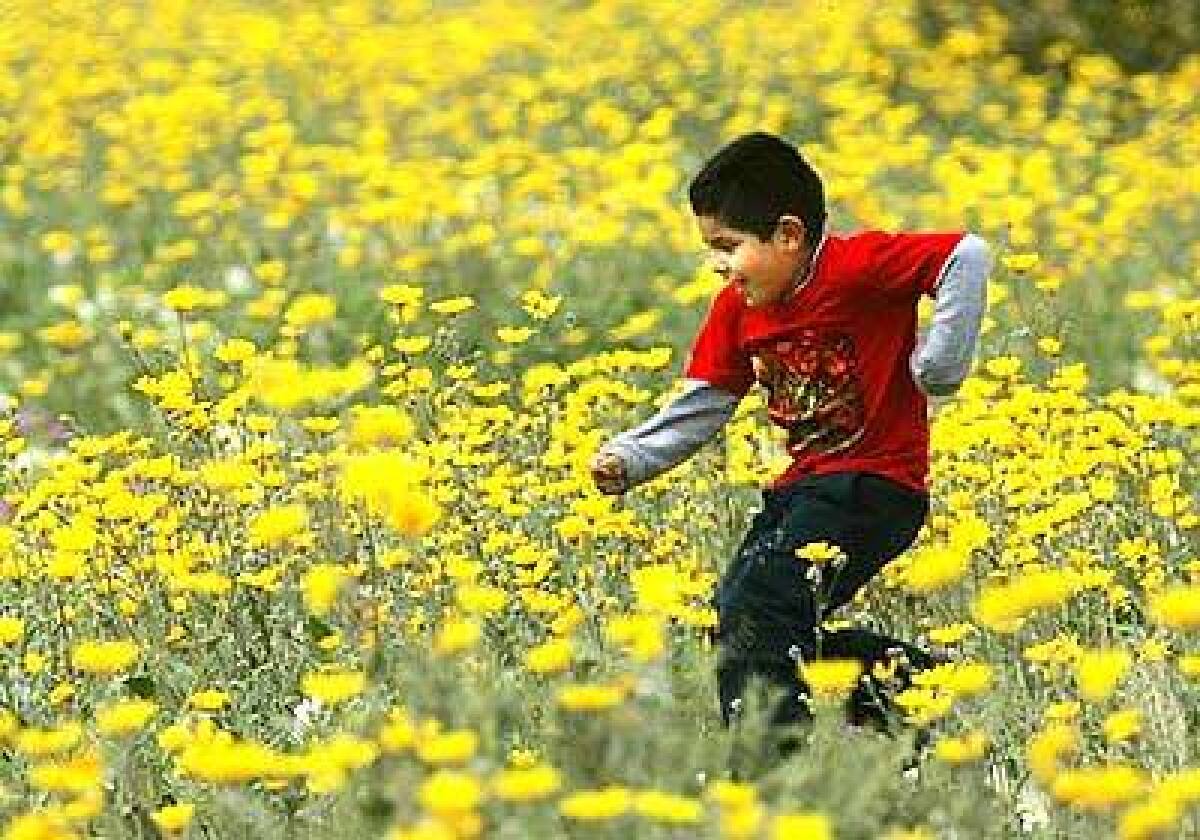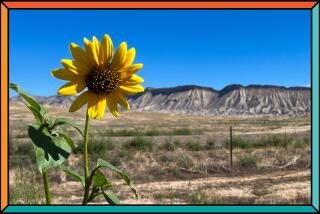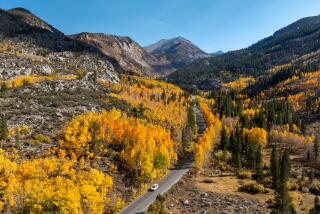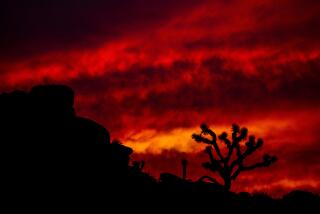Floral fireworks

The process is easy: just add water and the deserts of Southern California burst into color.
During the El Niño year of 1998, for instance, a series of rainstorms transformed a 40-mile stretch of Interstate 40 between Barstow and Needles into a carpet of gold, and while this year’s flowers can still be jeopardized by heavy rains or a sudden heat wave, 2005 promises to be a phenomenal year.
Already wildflower enthusiasts are making plans to follow the bloom from the lower elevations — Anza-Borrego, Joshua Tree and portions of Death Valley — in March to the higher elevations — the Mojave Preserve — in April and May. Most of the flowers below, and many others, will be found in all four regions, and the trail recommendations cover just a sliver of territory. No guide can do justice to such extravagance, but the point is simple: Spring passes swiftly, and while desert plants bloom intensely, they also bloom fleetingly.
 Chuparosa
Chuparosa
JUSTICIA CALIFORNICA
Growing on 2- to 7-foot-tall, nearly leafless shrubs, these brilliant red flowers are among the most important food sources for northbound hummingbirds in the spring. In Spanish, chuparosa means “rose sucker,” in reference to hummingbirds that depend so heavily on this plant that their migratory path follows its blooms northward. Habitat fragmentation and loss of these plants is prompting scientists to designate “protected nectar corridors” where other long-distance migrants like long-nosed bats, white-winged doves and monarchs might find dependable sources of food.
WHERE TO SEE IT
Mojave Preserve
In late spring, find chuparosa blooming at Cottonwood Wash, 10 miles north of Interstate 40 on Kelbaker Road. Turn left on a dirt road and travel two miles to the wash.
Anza-Borrego
Little Surprise Canyon has a rock garden with lupine, phacelia, ghost flower, chuparosa, desert five-spot and woody bottle washer. It’s just west of Borrego Springs along Highway S22, south of the parking area for Hellhole Canyon (behind the restrooms).
 Brittlebush
Brittlebush
ENCELIA FARINOSA
Forming spectacular and aromatic globes of yellow on rocky slopes and fans, the brittlebush stands 1- to 5 feet tall and is one of the desert’s most conspicuous plants. With deep roots and coats of shining white hairs, it is a marvelous structure. At its base it forms a compact cluster of small gray-green leaves from which longer stems with flowers and large bright green leaves arise. Green leaves (and flowers for that matter) are an ephemeral luxury that the plant can afford only when there is abundant water. But the smaller leaves remain through the summer because they are covered with air-filled hairs that reflect 70% of incoming sunlight and keep the leaf shaded so it can survive the intense heat. Evidence shows that brittlebush has been growing in the Southwestern deserts for at least 40,000 years.
WHERE TO SEE IT
Death Valley
Virgin Springs Canyon is where brittlebush - and golden evening primrose, desert dandelion anddesert chicory - can be found. It is one-half mile west of Jubilee Pass on a high-clearance dirt road on the north side of Highway 178.
 Desert dandelion
Desert dandelion
MALACOTHRIX GLABRATA
Often found along roadsides, these canary-yellow dandelions look so much like common yard weeds that visitors would scarcely notice them among the more exotic wildflowers - except that in good years they can carpet the ground with great masses of overlapping flowers. Desert dandelions are further distinguished by the red centers that young flowers have until fully open. At night, dandelions close up and hang like drooping bells, only to open with an enthusiastic face in the rising sun the next morning. The plant’s rosette of finely lobed leaves mostly wither by the time the flowers open. One reason for the plant’s apparent success is that yellow is a neutral color that attracts many different pollinators, plus the flower is structured to offer easy access for all insects.
WHERE TO SEE IT
Joshua Tree
Desert dandelions bloom south of the Oasis Visitor Center, just off Highway 62, east of Twentynine Palms. They also bloomalong Pinto Basin Road. Death Valley Virgin Springs Canyon
 Blue-eyed scorpion weed
Blue-eyed scorpion weed
PHACELIA DISTANS
These dainty-looking plants somehow thrive amid gnarled shrubs and rough, rocky ground, especially in washes where runoff collects after a rain. Fern-like leaves lend these plants other common names such as lace-leaf phacelia and fern-leaf phacelia. Also called wild heliotropes, they have characteristic flower clusters perched prominently atop curled stalks that look like the tails of scorpions. As each flower is pollinated, it sets seed while the next flower in line begins to open. The gradual sequence of opening flowers unfurls the stalk in slow motion. These are lovely flowers, full of saturated blues and long, elegantly tipped stamens.
WHERE TO SEE IT
Joshua Tree
The best displays for phacelias can be found at the Cottonwood area and the southern entrance to the park, west of the Chiriaco Summit and north of Interstate 10.
Anza-Borrego
Little Surprise Canyon
Death Valley
Ashford Mill
Desert sand verbena
ABRONIA VILLOSA
Sand verbenas are the dazzling stars of the desert wildflower show, especially in the dimming light of sunset when their pinkish-purple flowers seem to generate an inner glow. These stunning flowers literally carpet miles of sandy flats, where they mingle with yellow sunflowers and white primroses. During the day, the flowers rely on their colors to attract pollinators such as bees and butterflies, but after sunset they begin releasing fragrances to attract night-pollinating moths. Though sand verbena flowers lack true petals, the petal-like “perianths” are no less beautiful. Up close they are perfectly symmetrical and shaped somewhat like snowflake crystals. The rest of the plant, with long stems and thick rounded leaves, sprawls loosely across the shifting sand and around the edges of salty soils.
WHERE TO SEE IT
Death Valley
Ashford Mill sits at the base of the Confidence Hills, whose alluvial fans (no trails) providegood viewing for verbena. Take Highway 178 to the south end of the valley, almost 40 miles south of Furnace Creek.
 Dune evening primrose
Dune evening primrose
OENOTHERA DELTOIDES
These flamboyant dune specialists are one of the few plants that do well on shifting desert sands. And if their floral displays are any indication, they must be successful. Their large, floppy white petals are a conspicuous part of the spring bloom as they provide sharp contrast to the yellows, blues and purples of other flowers. But their true nature is best revealed when the sun slides behind the western hills; this is when primroses release sweet fragrances and lure huge sphinx moths to their saucer-like flowers. This plant’s oddest trait is revealed after it dies. As its long branches dry, they curl upward to form a football-shaped “cage” around the central seed axis, which further splits into twisted prongs. The whole affair looks somewhat like a dried Medusa-head, giving it popular nicknames such as devil’s lantern, desert bird cage or lion-in-a-cage.
WHERE TO SEE IT
Death Valley
Virgin Springs
Anza-Borrego
Thimble Trail
 Desert lily
Desert lily
HESPEROCALLIS UNDULATA
Closely resembling an Easter lily, this flower seems entirely unsuited for desert life. The only way desert lily can survive is to bury its edible, garlic-like bulb several feet deep in the soil where it won’t get wet and rot during a summer rain. Only the slow soaking rains of winter reach the bulb and trigger its splendid flowering cycle. Then, after a particularly wet winter, the plant’s stout stem rises one or more feet above the sandy desert to display a spray of 2-inch-long, trumpet-shaped flowers. Night-flying sphinx moths use their proboscises to reach deep into the swooping tubes of these magnificent flowers and find hidden packets of sweet nectar. In the process, the moths brush their faces against the flowers’ anthers and become dusted with pollen. White flowers, like those of the desert lily, are often specially adapted for nocturnal pollinators such as moths or bats.
WHERE TO SEE IT
Anza-Borrego
The ThimbleTrail leads into the Borrego Badlands, where you will find a valley with some excellent desert lilies. It is about 11 miles east of Borrego Springs on the south side of S22.
 Desert pincushion
Desert pincushion
CHAENACTIS FREMONTII
As its name suggests, this white-flowered species consists of disk flowers arranged like a dense pincushion. Pale yellow reproductive parts emerge from open flowers, while unopened flowers in the center of the cluster have the appearance of tiny cotton balls. These flowers are one of the top 12 sources of nectar for butterflies, and the plant is one of the main food plants eaten by desert tortoises. Growing about a foot tall, with slender linear leaves, it is one of the most common desert annuals on gravelly soils below 5,000 feet. They are particularly abundant where they find shelter around shrubs such as creosote. Later in the season, their seeds will be lofted into the wind by four sail-like scales that stick out from the seed and become lodged in rocky crevices, where they will have the best chance of survival.
WHERE TO SEE IT
Mojave Preserve
Explore the west side of the preserve on Kelbaker Road between Bakerand Interstate 40. Later this spring, one of the best sites for pincushion is almost 25 miles south of Baker.
Catching the desert bloom
For more information about desert parks, contact:
Death Valley National Park
(760) 786-3200 or https://www.nps.gov/deva/FrameSet-Wildflower.htm
Joshua Tree National Park
(760) 367-5500 or https://www.nps.gov/jotr/activities/blooms/ blooms.html
Mojave National Preserve
(760) 733-4040 or https://www.nps.gov/moja/mojaanwf.htmAnza-Borrego Desert
State Park
(760) 767-5311 or https://www.anzaborrego.statepark.org/ wildflowers.htmlThe Theodore Payne Foundation for Wildflowers and Native Plants in Sunland maintains a wildflower hotline from March through May at (818) 768-3533 or www.theodorepayne.org.
More to Read
Sign up for The Wild
We’ll help you find the best places to hike, bike and run, as well as the perfect silent spots for meditation and yoga.
You may occasionally receive promotional content from the Los Angeles Times.






